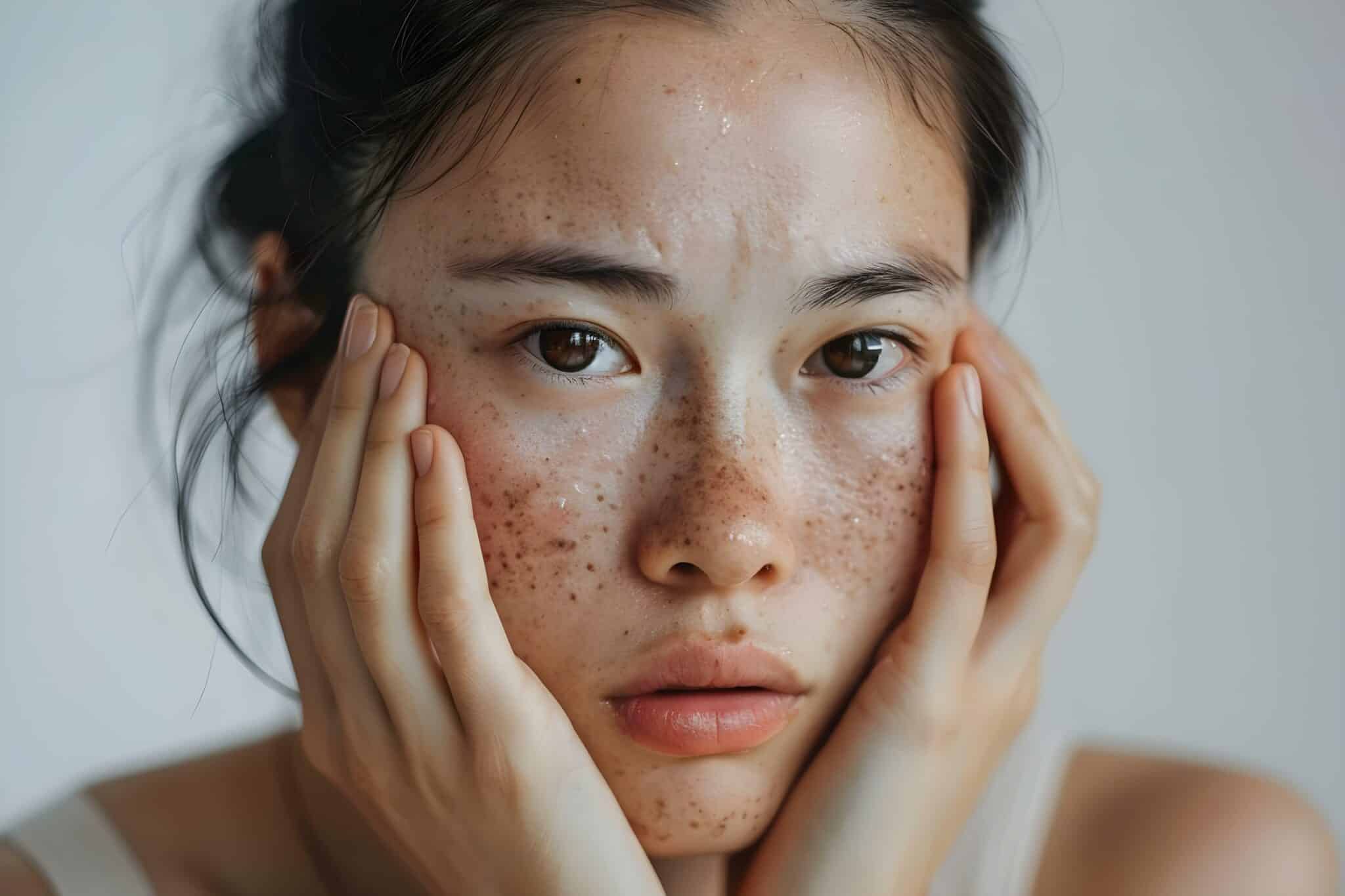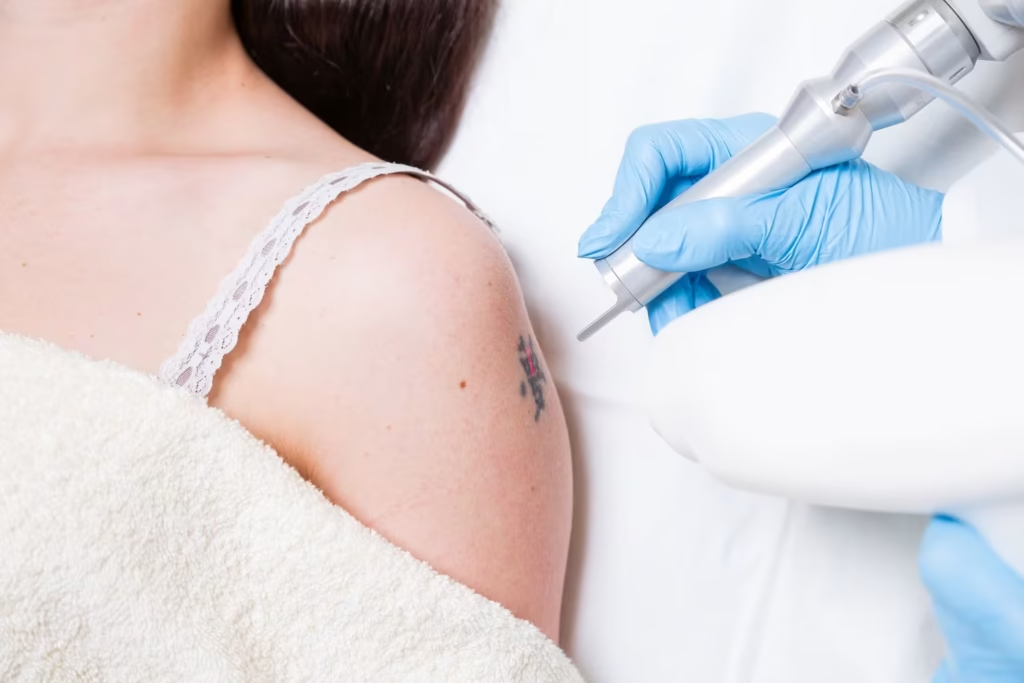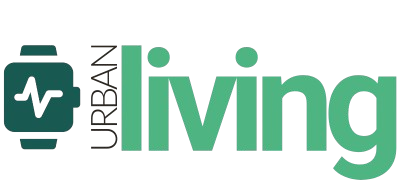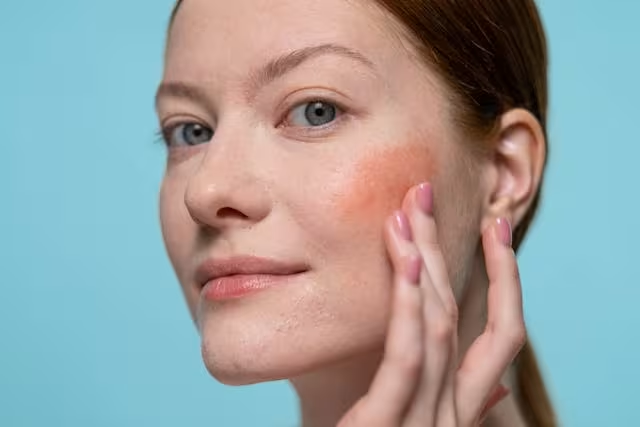Are you struggling with skin pigmentation, acne scars, or looking for effective skin rejuvenation solutions?
Q-switched laser treatment has emerged as one of Singapore’s most popular and trusted dermatological procedures. This comprehensive guide explores everything you need to know about Q-switched laser therapy, its benefits, applications, and why it might be the right choice for your skin concerns.
What is Q-Switched Laser Treatment?

Q-switched laser treatment utilizes advanced technology that delivers high-intensity laser energy in extremely short pulses (measured in nanoseconds). The term “Q-switched” refers to the technique used to create these ultra-short, powerful bursts of laser energy.
This specialized laser operates at specific wavelengths—typically 1064nm and 532nm—that target colored pigments in the skin without damaging surrounding tissues.
Modern Q-switched laser systems, such as those incorporating the Curas Hybrid technology, represent significant advancements over conventional Q-switched lasers.
These next-generation devices feature enhanced laser systems that optimize performance through multiple laser modes designed to treat various skin concerns with greater precision and effectiveness.
You might be interested in: The Ultimate Guide to Laser Hair Removal in Singapore
How Does Q-Switched Laser Technology Work?
The Q-switched laser functions on the principle of selective photothermolysis, which means it precisely targets specific chromophores (color-bearing particles) in the skin while leaving surrounding tissues untouched.
When the laser energy hits these pigmented particles, it causes them to fragment into smaller pieces that can then be naturally eliminated by the body’s immune system.
What makes the advanced Q-switched laser particularly effective is its beam profile. High-quality systems feature a “top hat” beam profile, meaning the energy is uniformly distributed across the treatment area. This uniform delivery allows for:
- More precise targeting of skin concerns
- Lower energy requirements for effective treatment
- Reduced risk of side effects
- More comfortable treatment experience
Additionally, modern Q-switched laser systems offer multiple operating modes that can be tailored to specific skin concerns:
- Q-Switch Mode: Delivers twin pulses with high peak energy to treat pigmentation with minimal pain
- Melasma Mode: Provides stronger photothermal effects to clear larger, deeper pigmented lesions
- Genesis Mode: Stimulates collagen production in the deep dermis while adding additional photothermal resolution for conditions like melasma
Related Article: List of Aesthetic Treatments and Costs in Singapore
Benefits of Q-Switched Laser Treatment
Q-switched laser therapy offers numerous advantages that have made it a cornerstone of aesthetic dermatology in Singapore:
Effective Pigment Removal
The Q-switched laser excels at targeting and removing unwanted pigmentation, including:
- Age spots and sun damage
- Freckles and lentigines
- Post-inflammatory hyperpigmentation
- Melasma patches
- Uneven skin tone
Most pigmentation concerns show significant improvement, with clinical studies demonstrating 70-90% clearance or lightening of pigmented lesions after a proper treatment course.
Acne and Acne Scar Management
For those struggling with persistent acne and residual scarring, Q-switched laser offers dual benefits:
- Eliminates acne-causing bacteria (P. acnes)
- Reduces inflammation associated with breakouts
- Shrinks oil glands in the skin for better oil control
- Minimizes the appearance of existing acne scars
- Prevents the formation of acne marks after breakouts
Collagen Stimulation and Skin Rejuvenation
Beyond targeting specific concerns, Q-switched laser treatment provides overall skin enhancement through:
- Enhanced collagen production for improved skin elasticity
- Removal of dirt, dead skin cells, and superficial facial hair
- Reduction in pore size for smoother skin texture
- Diminished appearance of fine lines and wrinkles
- Overall improvement in skin brightness and radiance
Tattoo Removal
Q-switched laser is widely considered the gold standard for tattoo removal due to its ability to:
- Break down various ink colors (particularly effective for black, dark blue, and red inks)
- Target ink particles at different skin depths
- Gradually fade unwanted tattoos over multiple sessions
- Achieve significant clearance with minimal risk of scarring
Non-Invasive with Minimal Downtime
One of the most appealing aspects of Q-switched laser treatment is its convenience:
- Non-ablative procedure that doesn’t remove skin layers
- Minimal discomfort during treatment
- Brief recovery period (mild pinkish flush for about 15 minutes)
- Ability to apply makeup immediately after treatment
- Return to normal activities immediately after the procedure
You might be interested in: Non-Invasive Body Contouring Treatments in Singapore
Comparing Q-Switched Laser with Other Laser Treatments
When considering laser treatment options in Singapore, it’s helpful to understand how Q-switched laser compares to other popular laser therapies:
Q-Switched Laser vs. Vbeam Laser
| Feature | Q-Switched Laser | Vbeam Laser |
|---|---|---|
| Primary Target | Pigmentation, acne, overall rejuvenation | Redness and vascular issues |
| Mechanism | Targets pigmented cells and stimulates collagen | Targets blood vessels in the skin |
| Best For | Acne, acne scars, pigmentation, tattoo removal | Rosacea, facial redness, vascular lesions |
| Downtime | Minimal (15 minutes of mild flush) | Slightly more (bruising possible) |
| Versatility | Highly versatile for multiple concerns | More specialized for vascular conditions |
Q-Switched Laser vs. CO2 Laser
| Feature | Q-Switched Laser | CO2 Laser |
|---|---|---|
| Treatment Type | Non-ablative (doesn’t remove skin layers) | Ablative (removes outer skin layers) |
| Intensity | Moderate | High intensity |
| Best For | Pigmentation, mild to moderate acne scars | Deep acne scars, significant aging concerns |
| Downtime | Minimal | Longer recovery (5-14 days) |
| Pain Level | Mild to moderate | More uncomfortable, often requires anesthetic |
| Results | Gradual improvement with multiple sessions | More dramatic results, fewer sessions |
Professional vs. “No-Frills” Q-Switched Laser Treatments
It’s worth noting the difference between comprehensive clinical Q-switched laser treatments and the “no-frills” options available in some establishments:
| Aspect | Professional Q-Switched Treatment | No-Frills Treatment |
|---|---|---|
| Treatment Approach | Customized to individual needs | Standardized for everyone |
| Session Duration | 12-15 minutes | 1-2 minutes |
| Frequency | Once every 3-4 weeks | Up to 3-7 times per week |
| Energy Settings | Tailored to skin type and concern | Not individualized |
| Cost Per Session | $180-300 | $30-50 |
| Total Cost for Results | Often more economical long-term | Can be more expensive in total |
| Risk of Side Effects | Lower due to personalization | Higher due to frequent sessions |
What Skin Concerns Can Q-Switched Laser Treat?
Pigmentation Disorders

The Q-switched laser is particularly effective for various types of pigmentation:
- Solar Lentigines and Age Spots: These sun-induced dark spots respond excellently to Q-switched laser, typically clearing in 2-3 sessions using the 532nm wavelength.
- Freckles: Natural or sun-induced freckles can be significantly lightened or removed with targeted treatment.
- Melasma: This challenging condition benefits from the multiple modes of advanced Q-switched lasers. The combination of Q-switch, Melasma, and Genesis modes provides more effective treatment than conventional lasers.
- Post-Inflammatory Hyperpigmentation (PIH): The photothermal effect of longer pulse durations in Melasma and Genesis modes is particularly effective for PIH, which conventional lasers often struggle to treat.
You might want to read: Laser Skin Pigmentation Treatment in Singapore
Acne and Related Concerns
Q-switched laser offers a multi-faceted approach to acne management:
- Active Acne: By killing P. acnes bacteria and reducing sebaceous gland activity, the treatment helps control active breakouts.
- Acne Scars: The collagen-stimulating effects help improve the appearance of shallow to moderate acne scars over time.
- Oil Control: Many patients notice significant improvement in oiliness after treatment, with fewer breakouts in the future.
Read more: The Ultimate Guide to Acne Removal in Singapore
Skin Rejuvenation
As an effective skin rejuvenation option, Q-switched laser:
- Improves Skin Texture: By stimulating collagen production and removing surface impurities.
- Reduces Pore Size: The tightening effect on the skin helps minimize the appearance of enlarged pores.
- Brightens Complexion: Regular treatments create an overall brighter, more radiant appearance.
- Addresses Fine Lines: The collagen-building properties help reduce the appearance of early signs of aging.
Vascular Concerns
The 532nm wavelength of the Q-switched laser can effectively treat certain vascular issues:
- Facial Redness: Helps minimize diffuse redness and blotchiness.
- Spider Veins: Can reduce the appearance of small, superficial blood vessels.
- Rosacea: May help manage some of the visible manifestations of rosacea.
Tattoo Removal

Q-switched laser remains the treatment of choice for unwanted tattoos:
- Black and Dark Blue Ink: The 1064nm wavelength is particularly effective.
- Red Ink: The 532nm wavelength targets red pigments effectively.
- Other Colors: Results vary based on specific ink compositions and colors.
Read more: Everything You Need to Know About Tattoo Removal in Singapore
The Treatment Experience: What to Expect
Before Treatment
Prior to your Q-switched laser session, your dermatologist will typically:
- Conduct a thorough skin assessment
- Discuss your medical history and any medications
- Establish realistic expectations based on your specific concerns
- Recommend the appropriate treatment protocol
- Take baseline photographs for comparison
During Treatment
The actual Q-switched laser procedure is relatively straightforward:
- Your skin will be cleansed to remove makeup, oils, and impurities.
- Both you and the practitioner will wear protective eyewear.
- The laser handpiece will be moved across the treatment area, delivering pulses of energy.
- You may feel what patients describe as “tiny hot dots” on your skin—generally tolerable without anesthesia.
- Depending on the treatment area, the session typically lasts 12-15 minutes.
After Treatment
Post-treatment care is minimal but important:
- A mild pinkish flush might appear for about 15 minutes.
- You can apply makeup immediately after treatment if desired.
- Normal activities can be resumed right away.
- Sun protection is crucial—avoid direct sun exposure for 7-10 days and apply broad-spectrum sunscreen diligently.
- For pigmentation treatments, small scabs may form and naturally flake off within a week.
Treatment Course
For optimal results:
- Most concerns require multiple treatment sessions.
- Sessions are typically scheduled every 3-4 weeks.
- Pigmentation issues might show improvement after 2-3 sessions.
- Acne and skin rejuvenation benefits often become noticeable after 3-4 treatments.
- Tattoo removal requires the most sessions, ranging from 5-20 depending on the tattoo’s age, colors, and depth.
Read more: Guide to Finding a Good Aesthetic Doctor in Singapore
Advanced Q-Switched Laser Technology Features
Modern Q-switched laser systems offer significant advantages over conventional models:
Stable and Uniform Energy Delivery
Advanced systems feature auto-calibration functions that ensure precise and stable energy delivery with a uniform beam profile throughout treatments. Real-time monitoring systems allow practitioners to verify consistent laser delivery, unlike some systems that may exhibit inconsistent output after prolonged use.
Enhanced Efficiency Through Multiple Modes
The integration of various operating modes allows for more comprehensive treatment:
- PTP (Progressive Thermal Pulse) Mode: Delivers high peak energy in twin pulses with short intervals for faster and safer treatment with minimal pain.
- Top Hat Beam Profile: Ensures uniform energy distribution regardless of power settings, delivering accurate treatment without affecting surrounding tissues.
- Preset Protocol Options: Includes expert-developed treatment protocols for specific conditions like melasma, combining different modes for optimal results.
Special Considerations for Different Skin Types
One of the advantages of advanced Q-switched laser systems is their suitability for all skin types, including darker Asian skin that is more prone to post-inflammatory hyperpigmentation. The even and precise energy distribution allows for treatment at lower energy levels, reducing risks while maintaining efficacy.
However, treatment protocols should always be tailored to individual skin types:
- Fair Skin (Types I-II): May tolerate higher energy settings with minimal risk of complications.
- Medium Skin (Types III-IV): Requires balanced settings to effectively target concerns while avoiding hyperpigmentation.
- Darker Skin (Types V-VI): Benefits from more conservative settings and potentially more sessions to achieve results safely.
Comprehensive Q-Switched Laser FAQ
Is Q-switched laser treatment painful?
Most patients find Q-switched laser treatment tolerable. The sensation is often described as feeling like many tiny hot dots on the skin. Advanced Q-switched lasers with twin pulse technology often deliver treatment with significantly less discomfort compared to conventional single-pulse systems. Topical numbing cream can be applied for sensitive individuals, but most patients proceed without it.
How much downtime should I expect after treatment?
Q-switched laser is known for minimal downtime. You might experience a mild pinkish flush for about 15 minutes after treatment, but this quickly subsides. You can apply makeup immediately afterward and return to your regular activities.
For treatments targeting specific pigmented lesions, tiny scabs may form and naturally flake off within 5-7 days.
How many sessions will I need to see results?
The number of required sessions depends on your specific concern:
- Pigmentation issues typically show significant improvement after 2-3 sessions
- Acne management and skin rejuvenation generally require 4-6 sessions
- Tattoo removal is most variable, requiring anywhere from 5-20 sessions depending on the tattoo’s age, colors, and depth
For optimal results, sessions are typically scheduled every 3-4 weeks to allow adequate skin recovery between treatments.
Is Q-switched laser safe for all skin types?
Yes, advanced Q-switched laser systems with proper calibration and settings are safe for all skin types, including darker Asian skin. The key is working with an experienced practitioner who can adjust parameters appropriately for your specific skin type.
The precision beam profile of modern systems allows treatment at lower energies, which is particularly beneficial for skin types prone to post-inflammatory hyperpigmentation.
Can I undergo Q-switched laser treatment while on oral Isotretinoin (Accutane)?
Unlike some laser procedures that are contraindicated during Isotretinoin treatment, Q-switched laser is generally considered safe since it’s a non-ablative procedure.
However, it’s essential to inform your dermatologist about any medications you’re taking, as they might adjust treatment parameters accordingly.
How does Q-switched laser compare to “no-frills” laser treatments?
While “no-frills” treatments might seem more economical initially due to lower per-session costs (sometimes as low as $30 compared to $180-300 for comprehensive treatments), they have several disadvantages:
- They use standardized settings rather than customized approaches
- Each session is significantly shorter (1-2 minutes versus 12-15 minutes)
- They require much more frequent sessions (sometimes 3-7 times weekly)
- The cumulative cost for comparable results is often higher
- The risk of side effects increases with more frequent treatments
What’s the difference between Q-switched laser and Pico laser?
Both target similar concerns, but differ in technology:
- Q-switched lasers emit energy in nanoseconds (billionths of a second)
- Pico lasers emit energy in picoseconds (trillionths of a second)
While Pico lasers are sometimes marketed as superior due to shorter pulse duration, clinical studies show that the photothermal effect of quality Q-switched lasers can be equally or more effective for certain conditions, particularly melasma and deeper pigmented lesions.
Advanced Q-switched systems with multiple modes offer excellent results with potentially less cost than Pico technology.
What side effects might occur with Q-switched laser treatment?
When performed properly, side effects are minimal but may include:
- Temporary redness (usually resolves within hours)
- Mild swelling in sensitive areas
- Darkening of pigmented areas before they lighten (normal part of the healing process)
- Rarely, hypopigmentation (lightened spots) or hyperpigmentation (darkened spots)
The risk of significant side effects is minimized with properly calibrated equipment and appropriate treatment parameters for your skin type.
How much does Q-switched laser treatment cost in Singapore?
Treatment costs in Singapore typically range from $180-300 per session for comprehensive, professionally administered Q-switched laser treatments. The exact price depends on:
- The specific concern being treated
- The size of the treatment area
- The clinic’s location and reputation
- The experience level of the practitioner
- The specific technology being used
Many clinics offer package pricing for multiple sessions, which can reduce the per-treatment cost.
How should I prepare for a Q-switched laser treatment?
For optimal results:
- Avoid sun exposure for 1-2 weeks before treatment
- Discontinue retinoids and exfoliating products 3-5 days prior
- Arrive with clean skin free of makeup
- Inform your practitioner about any medications you’re taking
- Mention any history of cold sores if facial treatment is planned
- Take photos of your concerns beforehand to track progress
What aftercare should I follow?
After Q-switched laser treatment:
- Apply sunscreen diligently (SPF 30+ and broad-spectrum)
- Avoid direct sun exposure for 7-10 days
- Use gentle, non-irritating skincare products
- Stay hydrated to support skin healing
- Avoid picking at any tiny scabs that form
- Postpone other facial treatments for at least a week
Can Q-switched laser be combined with other treatments?
Yes, Q-switched laser works well as part of a comprehensive skin improvement plan. Common complementary treatments include:
- Chemical peels for enhanced exfoliation
- Hydrating facials between laser sessions
- LED light therapy for additional acne control
- Microneedling for advanced collagen stimulation (scheduled between laser treatments)
- Appropriate skincare regimens to maintain and enhance results
Your dermatologist can create a personalized treatment plan combining different modalities for optimal results.
Choosing the Right Clinic for Q-Switched Laser Treatment
When selecting a provider for Q-switched laser treatment in Singapore, consider these factors:
Technology and Equipment
Look for clinics that offer advanced Q-switched laser systems with features like:
- Multiple treatment modes (Q-switch, Melasma, Genesis)
- Top hat beam profile technology
- Real-time energy monitoring systems
- Dual wavelength capabilities (1064nm/532nm)
Practitioner Expertise
The skill of your practitioner significantly impacts results:
- Seek board-certified dermatologists or experienced aesthetic physicians
- Ask about their specific experience with Q-switched laser
- Request before-and-after photos of previous patients
- Read reviews focused specifically on laser treatments
Customized Approach
Quality treatment should be tailored to your needs:
- Comprehensive skin assessment before treatment
- Customized settings based on your skin type and concerns
- Detailed explanation of the expected treatment course
- Realistic discussion of potential results
Aftercare Support
Proper aftercare enhances outcomes:
- Clear written instructions for post-treatment care
- Availability for follow-up questions
- Appropriate product recommendations
- Scheduled review appointments to assess progress
Conclusion: Is Q-Switched Laser Right for You?
Q-switched laser treatment represents an effective solution for many common skin concerns, particularly for those seeking:
- Non-invasive treatment with minimal downtime
- Effective management of pigmentation issues
- Improvement in acne and acne scarring
- Overall skin rejuvenation and brightening
- Tattoo removal or fading
The advancements in Q-switched laser technology, particularly systems with multiple treatment modes and precise beam profiles, have significantly enhanced the safety and efficacy of these treatments for all skin types.
For best results, seek treatment from qualified practitioners using advanced systems, and commit to the recommended treatment course and proper sun protection.
Whether you’re dealing with stubborn pigmentation, acne concerns, or simply seeking overall skin rejuvenation, Q-switched laser treatment offers a scientifically-backed approach to achieving clearer, more radiant skin with minimal disruption to your daily life.

